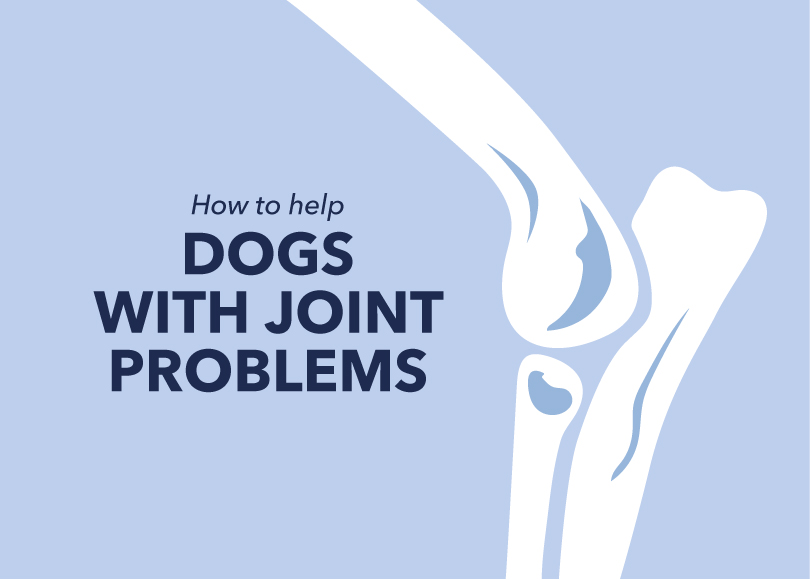With all the running, chasing, fetching and jumping they do, dogs know how to have a good time. Leading such an active life can often take its toll on a dog’s joints, which can lead to arthritis, so it’s important to know how you can help.
What causes joint problems?
Arthritis is usually the source of many joint problems in dogs. Arthritis literally means ‘inflammation of the joints’ and usually develops from wear and tear. Whilst more commonly seen in older dogs, certain breeds can be prone to arthritis at an early age, such as Labradors, Golden Retrievers, German Shepherds, Mastiffs, Great Danes and many other large and giant breeds. Arthritis can also develop from old injuries, immune disorders or genetic issues.
How do bad joints affect a dog’s life?
When arthritis occurs, the joint becomes inflamed and often painful. New bone is formed around the joint and the cartilage, which normally acts as a protective shock absorber, starts to deteriorate or even disappear. All these changes mean that the joint becomes stiffer and more difficult to move without causing pain or discomfort. This affects the mobility of the joint and means that dogs are less able or less willing to exercise freely. If exercise is a struggle, and dogs are reluctant to participate, dogs with arthritis often have a tendency to gain weight because of their reduced activity. Excess weight can put excess pressure on already unhealthy joints, which can increase pain and inflammation.
How can I help my dog?
Watching your dog suffer from joint problems is hard for any owner, but there are things you can do to help.
Exercise
Keeping up daily, gentle exercise is really important to keep joints mobile and prevent stiffness, which can lead to discomfort. Each dog’s capability for exercise will vary according to how bad their joints are and your vet can advise on a sensible programme for your dog, but maintaining daily walks is a good place to start.
Activities such as swimming or hydrotherapy can be very effective in easing joint issues and helping with comfort and mobility because they are low impact activities. A trained canine physiotherapist or hydrotherapist can achieve really remarkable results with even the stiffest of dogs. They can teach you a range of simple exercises to get into the habit of doing at home to improve your dog’s mobility.
Weight management
Keeping your dog at an ideal weight will help to reduce pressure on stiff joints. If you need to help your dog shift a little weight, this will mean carefully controlling portions and treats. If your dog is doing less exercise due to mobility issues, then their daily calories need to be reduced too.
When you sign up to tails.com, we take your dog’s weight, body condition, activity levels, breed and lifestyle factors into account to calculate exactly how many calories they’ll need. To remove any guesswork we also provide a Perfect Portion scoop with a detailed feeding plan to tell you exactly how much your dog needs.
Feeding
A high quality, balanced diet can play an important role in your dog’s overall health. On a tails.com diet, your dog’s blend is 100% optimised at all times throughout their life. We can boost immune function and support joint health by adding kibbles to your dog’s blend which contain higher levels of Omega oils. Our Blend Evolution process gradually and automatically changes the levels of these supplements as your dog matures, so you don’t even have to worry.
If your dog is a breed that we know to be prone to joint issues, we add in glucosamine and chondroitin from an early age. These are safe and natural supplements which provide the building blocks for the body to produce healthy cartilage and lubricating joint fluid, as well as helping prevent further destruction of joint tissues due to inflammation. The levels gradually increase as your dog gets older in order to support joint health throughout life, instead of only adding them when a dog is visibly stiff or in discomfort.
By nature, dogs are always trying to please their owners and can be masters of disguising pain and discomfort. Dogs who are unwell or suffering will often withdraw from family interactions and increase the time spent sleeping or resting in their beds. Sleeping more than usual can signal changes in health in the same way that being more lethargic or less energetic does. If your dog is showing stiffness, this may signal that they’re in pain, so visiting your vet for a physical exam and a discussion will help you to help your dog.

